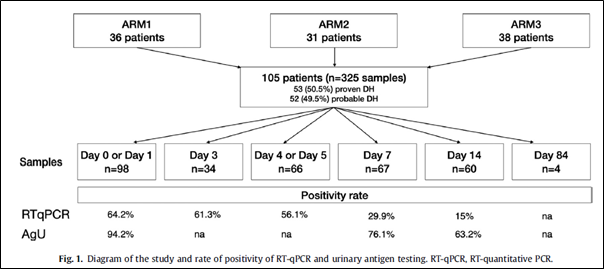A newly published study by Sturny-Leclère et al. (2025) examines the outcomes of people living with HIV with disseminated histoplasmosis (DH) undergoing treatment with liposomal amphotericin B (L-AmB). The researchers quantified Histoplasma from blood samples collected during a clinical trial in Brazil. The trial compared three L-AmB treatment regimens in 105 HIV-positive patients diagnosed with DH.
At the start, this test was positive in about 64% of patients, and even higher (89%) in those with confirmed infections. The fungal signal dropped steadily during treatment, with only 15% of patients still having a positive test by day 14, compared to 63.2% still with a positive antigen assay.
The RT-qPCR performance was compared with urine antigen detection, which had a higher initial positivity (94.2%) but lacked prognostic value.
This study demonstrates that RT-qPCR not only complements current diagnostic tools but also serves as a prognostic biomarker, identifying patients at risk of poor outcomes. Also shown is that the fungal load can decrease in patients treated by different regimens, suggesting that quantification by RT-qPCR is valuable.
The authors advocate for the incorporation of fungal load monitoring via RT-qPCR into routine management of HIV-associated DH, potentially guiding treatment intensification for high-risk patients. However, the study acknowledges limitations related to assay variability and the need for further prospective validation. No commercial PCR assay is available and no guideline yet recommends its routine use in diagnosis.

